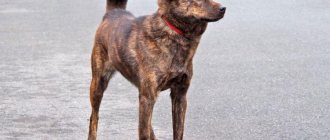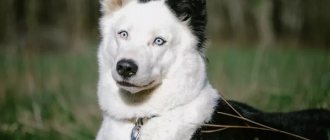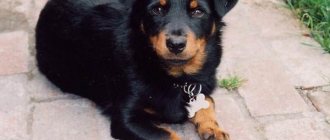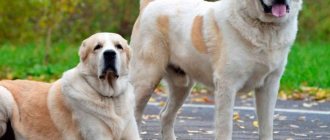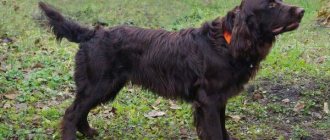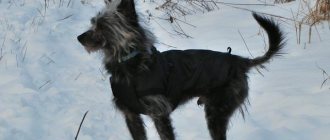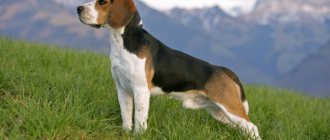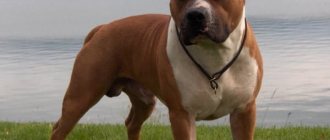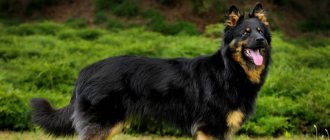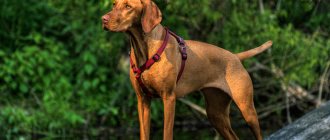| Origin: | Africa |
| Usage: | hunting, guarding, companion dog |
| Color: | red, sand, black |
| Dimensions: | height of males up to 70 centimeters, females - up to 65 centimeters |
| Lifespan: | 12-14 years old |
The Azawakh comes from Africa. Almost no selection was carried out on the breed. Its representatives are primitive dogs. Primitiveness means complete preservation of the original appearance.
Brief characteristics of the dog
- Other dog names: Tuareg Greyhound, Azawakh hound, Blue Berber Greyhound, Tuareg Sloughi, Tuareg Sloughi, Azawakh, South Saharan Hound.
- Adult height: 64-74 cm.
- Weight: 15-25 kg.
- Characteristic color: red-brown with white “stockings” on the paws and a white chest.
- Coat length: very short.
- Life expectancy: 10-12 years.
- Advantages of the breed: loyal, affectionate, good guard and hunter, smart, hardy.
- Difficulties of the breed: distrustful, non-communicative.
- Average price: from $500 to $1000.
Breed standard
The Azawakh in the photo looks muscular and lean, giving the impression of a sophisticated and elegant breed. In life, these physical characteristics are complemented by incredible endurance. With a height at the withers of up to 75 cm, males weigh no more than 25 kg. Bitches reach a maximum weight of 20 kg, and their height is no more than 70 cm.
The dog has a light, long and dry head with noticeable relief. The skull is almost flat, elongated. The stop is extremely weakly expressed. The nostrils are large, the nose has black or brown pigmentation. The long and strong jaws are set in a scissor bite.
The dog's eyes are large and almond-shaped. Their color is dark or amber. The ears are set high. They are thin and always hang. Visually they resemble a triangle with a somewhat rounded end.
The slightly arched neck is long and muscular, without dewlap, flowing smoothly into an almost straight back with pronounced withers and a short, arched loin. The chest is developed in length, deep, but not too wide. The tail is low set, long, thin and dry. The limbs also differ in length and thinness, they are almost completely vertical.
The thin skin fits tightly to the body, and the hair is short and fine. There is almost none on the stomach. Red colors with shades from sand to chestnut are acceptable. There may be small markings on the paws, tip of the tail and chest. Possible black tiger stripes.
History of the origin of the breed
When and how the African hound appeared is unknown. All knowledge about the origin of this breed boils down to the fact that many centuries, and possibly millennia ago, dogs were tamed and domesticated by African aborigines from the Tuareg tribe. Found rock paintings depicting such dogs date back to between the 20th and 8th centuries BC.
The breed got its other name from the Azerak Valley, which in translation sounds like “Land in the North”, and is located in the Southern Sahara in Mali, Burkina Faso, as well as Nigeria and runs along the middle reaches of the Niger River. It is assumed that the dogs descended from the ancient Arabian greyhound or slugi or saluki.
In Africa, a ban on the sale of Azawakhs was introduced for a long time. This breed came to Europe only in the 70s of the twentieth century thanks to the French diplomat Pecher, who received a long-awaited dog for helping local tribes. The next time he was thanked with a given bitch. So Pecher became the first breeder of African greyhounds on the European continent, and France became the patron of the breed.
At first, the dogs were considered a type of Slugi, and in 1981 they were officially registered as the Azawakh breed and recognized by the FCI. And the first full-fledged standard was adopted in 1994.
History of the Azawakh breed
The African Azawakh breed, according to some sources, appeared about more than fifteen thousand years ago. It is believed that greyhounds descend from wolves, which were domesticated in the pre-glacial period. In their homeland, these fast dogs were very popular. However, dog breeders in Europe and America knew nothing about them for a long time.
Greyhounds have long accompanied Bedouins from the Berber and Tuareg tribes who roamed the Sahara Desert. Lean and fast dogs helped their owners in hunting and guarded property. Purebred puppies were expensive, and not everyone could have such a dog. Therefore, for Africans, the Azawakh was not just a faithful comrade and assistant, but an indicator of a person’s high status.
The lean, short-format dogs from North Africa began to be named after the Azawad Valley, where the mysterious Tuareg tribe lived. The breed has other names: Tuareg hound, South Saharan hound, Blue Berber hound.
The first purebred African greyhounds were brought from Mali to France only in the late sixties of the 20th century. In 1980, the breed was officially recognized by the International Canine Federation, and it was legalized in America in 1993.
The breed came to Russia later than to other countries, in 1986. A couple of years later, Russian Azawakhs gave birth to their first offspring. In 1998, the National Breed Club was organized.
Purpose of the African Greyhound breed
The main purpose of the fast and hardy Azawakhs is to hunt animals from hare to gazelle. Developing speeds of up to 60 km/h, they can persistently pursue a victim for five hours. Having caught up with the game, the dog bites its tendons and remains waiting for the owner's subsequent commands. He can bring small game immediately, without waiting for instructions. Often the owners take them to the hunting site next to them on horseback so that the dog does not get tired.
A highly developed sense of ownership, jealousy of their territory, and suspicion of strangers make African hounds good guards.
In addition to hunting and guarding, Azawakhs are considered a status dog for many African peoples, since only a wealthy person can afford its purchase and further maintenance. And such dogs are very fond of various competitions, in which many of them easily take prizes.
Diet
The breed was bred as a companion to a person who lives in very ascetic conditions. He is always on the move. Naturally, no one would think about a special diet and care for dogs. Therefore, initially the dog ate the same as the owner. The basis of food in the desert: millet and goat's milk.
This means that the basis of the diet should be:
- cereals;
- vegetables and fruits;
- dairy products;
- a little meat or offal;
- a small amount of fish.
Of course, in modern conditions, an Azawakh can eat dry food. But it must be chosen taking into account the needs of a particular dog. The food is selected individually, preferably low-protein.
The Azawakh drinks little; his body is adapted to obtain water from food in sufficient quantity. But, as with any dog, fresh, clean water should be available at all times. Especially if you feed your dog prepared food.
Water is necessary for a dog that eats dry food. If there is not enough water, dehydration may occur.
Description of character and temperament
When you see adult dogs whose skeletons are covered with skin, it seems that they are emaciated and are about to die of starvation. It's all about their structure and muscle characteristics . In order to keep the body as cool as possible in the hot African conditions, Azawakhs have flat and dry muscles, which are attached obliquely to the bones, and the skin is so thin that sometimes it seems that it is translucent.
This effect is achieved by a large number of subcutaneous vessels, which act as a heat exchanger. But this rather fragile appearance is actually deceiving. African greyhounds are very agile, agile and resilient and are capable of chasing a hare at high speed under the scorching sun for hours. They must be on the move all the time, and this must be taken into account if you want to become the owner of such a dog.
Azawakhs are absolutely not intended for living in apartments, as they need a large open area where they will feel free and spacious. They practically do not get along with other pets. Even if you bring a puppy to a house where there are already other animals, all the same, when the dog grows up, he will begin to perceive them as an object of hunting.
The only dogs to which Azawakhs are friendly are their relatives. He also doesn’t get along very well with children, as he can’t stand intrusion into his own space.
Despite centuries of domestication, Azawakhs remain true to their independent and somewhat wild temperament. They recognize only one master, who must show himself from the first days as an undisputed leader and leader. The dog will serve him faithfully and devotedly, even showing affection and tenderness.
They treat the rest of their family with almost indifference, which cannot be said about strangers. They treat them very suspiciously and warily, but do not show aggression. In general, Azawakhs are not a friendly breed. But for their leader they will become a sensitive and moderately obedient companion.
Character
Azawakhs have a very complex character; they are independent, strong-willed dogs that tend to dominate. At the same time, they can be timid and touchy. Their temperament is difficult to describe. The Azawakh is a breed exclusively for amateurs. They are often compared to a cat; they are reserved, not affectionate, and must be accustomed to strangers from an early age. Despite belonging to the greyhounds, they are not particularly friendly; they have a pronounced watchdog and sometimes protective instinct.
The Azawakh has a very complex character. Don't think about buying a puppy just because of its appearance. A lot of people, including Greyhound breeders, were disappointed with what they received afterwards.
Growing up, the Azawakh becomes strongly attached to the family, becomes part of it, but sees the owner as only one person, and it is very difficult to bear separation from him. The Tuaregs highly value the Azawakhs for their strength of character, which is considered a sign of nobility and excessive sociability is not typical for it.
Azawakhs have a developed sense of territory. They do not like violation of personal space, rude treatment, noise and fuss. At home and in nurseries, they form flocks with a pronounced hierarchy. They can live with other dogs, but as long as their social relationships are established, conflicts and fights will arise. If Azawakhs gather in a pack, they become uncontrollable.
The Azawakh is not the best option if the family already has other animals. He can be aggressive towards other dogs and cannot always build friendly relationships due to his tendency to dominate, which is especially pronounced in males. Sometimes they get along well with medium-sized or large-sized dogs that do not show leadership qualities. Small dogs and cats are often perceived as potential prey. Those with whom he grew up are treated relatively calmly, but this does not apply to neighbors’ and other people’s animals. The Azawakh is intolerant of small animals and birds, which will have a hunting instinct in him.
The Azawakh is not suitable for families with small children due to its independent temperament and energy. He will not tolerate restrictions on his own freedom, is not the best companion for playing ball or bowl with a child, rarely listens to anyone other than the owner, and may accidentally push or snap on purpose if the child makes the dog uncomfortable. In addition, running children can trigger their hunter instinct and cause the Azawakh to chase them and knock them down. Dogs that are not familiar with children from an early age are suspicious of them, intolerant of noise and sudden movements.
How to choose a puppy
An African greyhound puppy is necessary and can only be purchased from a kennel or from a few breeders who purposefully breed the breed, ensuring its purity. As a rule, such places have all the conditions for keeping adult dogs and litters.
Each puppy must have a stamp confirming its breed, all necessary vaccinations and a puppy card. When purchasing a puppy, you will be given recommendations for further care and feeding.
How much do Azawakh puppies cost?
The rarer the breed, the more expensive the dog will be. Azawakh puppies in Russia can be bought for 50-80 thousand rubles. Offspring from sires brought from Africa are especially valued.
If the price is lower, it means they are trying to deceive you or there is something wrong with the dog. An honest breeder is obliged to warn that he is offering a cull puppy. For example, the color does not meet the standard or there are other serious flaws that will not allow the dog to take part in exhibitions and breeding. If this is not important to you, you can purchase an Azawakh at a lower cost.
Dog names
By the time you purchase a puppy, it will already have a name that is included in the metric, and is also pedigree and official. Whether you use this nickname in everyday life or give it another is up to you. The following nicknames may be suitable for the African hound:
- for males - Allen, Zidler, Gurkhan, Anzhey, Gringo, Dave, Lambert and others;
- for bitches - Zakira, Veggie, Michi, Jaina, Nike, Besta and so on.
As well as other names and nicknames that will be well perceived by the dog by ear, easy to remember and pronounce.
Choosing a puppy
Before adopting a baby, find out about his parents, ask the breeder to tell you in detail about his health, character, show his pedigree and the availability of health tests.
- Never take animals from your hands or without documents, such dogs may not be healthy. The best way is to find a breeder in advance.
An important point when choosing is how the baby behaves; if he is active and inquisitive, this indicates his mental health. Puppies must be vaccinated according to age,
The price for a puppy with pedigree and documents starts from 500 euros.
Care and maintenance
The very short and non-shedding coat of the Azawakh does not require special care or bathing. In order to clean a dirty pet or remove dust from the fur and give it a healthy shine, just wipe the body with a damp towel. And if necessary, you need to treat the dog’s fur from fleas and ticks.
More attention should be paid to the drooping ears of the African Greyhound. They require weekly care. And also keep your eyes and teeth clean.
African Greyhounds require constant movement and are not suited to living in cramped apartment conditions. They need space, which they can get in a country house with a large territory. They do not tolerate cold and drafts well, but any heat does not matter much to them. For this reason, it is not recommended to purchase African Greyhounds for countries or regions with cold climates.
Features of care
Maintenance and care, like the nutrition of a dog, has a certain importance in life, which affects its quality and duration.
So it’s very important for her not to get too cold, and because of her particular love for water, to avoid exposure to rain, especially if it’s spring or autumn outside.
The best solution would be if you buy a raincoat, or simply don’t take your dog outside at this time.
They require constant physical activity, long walks with sufficient load are important for it, the best option is obstacle course running, an equipped area for exercise, the owner taking a bike ride, morning and evening jogging with the animal.
Wool and bathing
You need to bathe your pet as it gets dirty, without getting too carried away with water procedures, and the water should not be hot, otherwise the skin will dry out.
- The use of special care products is required, which can be purchased in specialized stores. During the molting period, it is necessary to comb out the lower undercoat, which is not particularly developed, that is, there will be practically no hair.
After a walk, just wipe the paws and fur with a damp cloth; there is no need to rinse the dog completely. To do this, you need to have a separate, soft towel - which is not soft to the touch, since the skin of Azawakh representatives is quite delicate.
An important point is regular treatment for fleas and ticks, due to the smooth coat - they are easy to spot on the skin, but often they sneak into the ears, where they are almost impossible to detect. Ticks are dangerous insects that are carriers of a large number of diseases that lead to death - treat your pet in a timely manner, only with proven means.
Eyes, ears, teeth, claws
The eyes need to be treated with a special solution using a cotton swab, as they become dirty, or once a week, examining the mucous membranes. If the discharge is purulent and has an unpleasant odor, it is better to consult a specialist.
- Claws require trimming once every 2-4 weeks, depending on how long they have time to grow; the puppy should be accustomed to using a nail clipper in advance, starting from 3-4 months of age.
Representatives of hounds have claws that are not large in size, and due to constant activity they quickly wear down, but if this does not happen, then trim them yourself. If you do not do this on time, there is a possibility that the dog may break it and be seriously injured. If you don't get used to a haircut, this may become a problem in the owner's future.
Dental examinations should be regular; animals also suffer from caries and other dental problems. If you notice an unpleasant odor, this may indicate digestive problems. It is recommended for older dogs, as well as young ones, to brush their teeth themselves with a special brush, which will help avoid many diseases.
Regularly inspect your ears for ear plugs; if any have formed, remove them using a cotton swab and a special lotion.
African greyhounds, active and cheerful, are suitable for a country house or a large apartment with regular physical exercise for at least 4 hours a day.
- They absolutely cannot tolerate severe frosts - they need clothing, they do not like water, and it is not recommended to take them with them to a pond or in severe, cold climates.
Health
By nature, these are healthy dogs, hardy, but not prone to severe frosts or hypothermia. Having gone through a natural, terrible selection at the initial stage of the formation of the breed, they acquired excellent qualities that help them adapt and are practically not exposed to “typical canine diseases.” But unfortunately, they also have their own specific characteristics and predispositions to diseases.
Life expectancy is from 12 to 15 years, with good care, decent exercise and quality nutrition. Have a predisposition to:
- Diseases of the musculoskeletal system, joints - especially large ones;
- organs of vision, often with age they lose their vigilance, and some may become completely blind;
- Do not tolerate medications well, especially antibiotics;
- Susceptible to allergic reactions;
- Sudden changes in temperature can cause inflammatory diseases;
- Infectious respiratory diseases are possible.
By itself, it is quite strong, but in unfavorable conditions it can get sick, like any other animal.
Possible health problems
Azawakhs are hardy, strong and healthy dogs without many of the hereditary problems that are found in other breeds that have undergone artificial selection under human direction. Occasionally, they may experience epilepsy, as well as compression of the cervical vertebrae.
Dogs of any breed are susceptible to infectious viral diseases. And Azawakhs are no exception, despite their strong immune system. To avoid serious consequences, you need to give your pet the necessary vaccinations in a timely manner, and also do not neglect regularly taking medications for worms.
Health
Greyhounds from Africa are some of the healthiest dogs on the planet. What other breed can adapt to sweltering heat, lack of food and water in the required quantities and hunting under the hot sun.
Azawakhs have no genetic diseases. The only peculiarity of the breed is intolerance to cold. Starting from early autumn until late spring, the pet must be taken into the house. Take them out for walks in warm clothes.
Vaccinations
Standard complex. The first vaccinations are given by the breeder. Subsequent annual ones are the owner. The complex includes vaccination against rabies, distemper and infectious diseases.
Nutrition for puppy and adult dog
For a more balanced diet for the African greyhound, it is preferable to use dry food. It should be premium from trusted manufacturers, which ideally combines essential minerals and vitamins with other nutrients.
Also, the food must meet the dog’s needs and be suitable for its age. As a delicacy, the Azawakh will enjoy a sugar bone with great pleasure. And the dog must have some water, which he can drink at any time.
In order to relieve a dog of this size from unnecessary stress on the spine, bowls with water and food must be placed on a stand that can be adjusted in height as the pet grows.
Azawakh food
There is nothing special in the diet of these dogs. They are ready to consume the same food as other four-legged friends. The only caveat is that foods containing calcium should be available in sufficient quantities , because Azawakhs have a developed skeleton.
What is the basis of proper nutrition for Azawakhs?
- The main thing is not to feed only dry food . This will not benefit your dog's bones, fur or muscles. Be sure to buy vitamins and minerals for your dog.
- Liquid food should be mandatory in the Azawakh's diet : homemade soup, meat broth.
- Do not forget to periodically give your Azawakh large bones. The feeding habits are typical for both an adult Azawakh and a puppy of this breed.
Training and education
Azawakhs are smart and easy to train, quickly remembering everything that is asked of them. But training should be done by a person whom the dog perceives as a leader. It is recommended to undergo a training course with the help of a dog handler who understands the intricacies of canine nature.
And also, if you plan to use the African hound for its intended purpose, that is, as a hunter, then you should first train it, using the recommendations of an experienced specialist in this matter.
Diseases and care
These dogs are unpretentious in care. They do not require any special methods. The wool is virtually not subject to shedding. It is enough to scratch the animal a little with a rubber mitten. As with all breeds, regular eye and ear care is required, as well as treatment for external and internal parasites.
Doesn't like to swim, given its origins in the hot desert. Therefore, it is not recommended to wash the Azawakh often.
It is necessary to take care of your dog’s teeth, brush them with a special paste and regularly take them to the veterinarian for examinations.
As for diseases, it can be noted that African greyhounds have good health. They underwent strict selection from the nomads. From the litter, 1-2 of the strongest representatives were left, because the living conditions of the desert required the hardiest and healthiest animals nearby. Of course, diseases will pass by, with proper care and maintenance.
There are practically no hereditary diseases. Very rarely:
- hip dysplasia;
- cardiovascular;
- neurology (epilepsy).
The biggest threat to a healthy Azawakh is hypothermia. Colds are very common for them in cold weather.
The African Greyhound is a dog with a minimal amount of subcutaneous fat. Particular care must be taken in dosing medications and using anesthesia.
Advantages and disadvantages
African Greyhounds are not dogs that will be a friend and companion for the whole family. Having designated one owner for themselves , they will treat him faithfully, with kindness, obedience and tenderness. The rest will be shown restraint and indifference.
These dogs are not suitable for those who have small children who will interfere with their personal space. Azawakhs do not tolerate this very well. For the same reason, they react warily to strangers, and they make good guards, zealously defending their territory.
By their nature, Azawakhs are dexterous and hardy hunters, capable of chasing prey for hours and even grabbing a bird at the moment of takeoff. They often practice these instincts on other pets with whom they find it difficult to get along.
This breed is not known for its friendliness, but anger and aggression are not inherent in them either . Independent, freedom-loving, playful and active dogs need space and freedom of movement.
They are not suitable for living in urban environments, much less in apartments. They also do not tolerate cold climates well.
How to feed
The nutrition of a puppy and an adult dog differs significantly from each other. Small puppies eat 4-5 times a day, in small portions, every 4-5 hours. Adults eat 2 times a day.
The best option is dry food, which is already balanced and contains all the micronutrients and minerals.
The best are premium foods that are specially designed for hounds. Nutrition is selected based on age and activity. When feeding dry food, there must be constant access to water. Special bones are purchased as a treat and as a bonus for brushing teeth.
Categorically exclude from the diet: pieces from the table, bones, fatty, salty, smoked, baked goods, sweets. If your pet is on a natural diet, it is necessary to correctly calculate the daily calorie requirement, as well as regularly give mineral supplements and vitamins.
Under no circumstances alternate dry feeding with natural feeding; the animal will eat falsely, only a certain type, and does not need additional feeding.
Reviews
Konstantin:
The breed captivated us with its working qualities and unusual appearance. I am a hunter and greyhounds are my weakness. I waited a long time for my Jackie, I even had to go abroad to the nursery myself. I believe that buying one from dubious advertisements is an unjustified and expensive risk. My dog turned out to be a wonderful hunter, or rather a huntress. The training went off with a bang, but she only perceives me, and her wife and son don’t seem to exist for her. In general, I am very pleased with the long-awaited acquisition.
Anatoly:
I always take my Azawakh with me hunting and never return home without catch. If I come across newcomers, I always catch glances in the direction of the dog full of pity. They think that it was me, such a beast, who brought the dog to exhaustion, until they see it at work and find out about the breed.
Share your Azawakh stories with us. It would be interesting to know where you got the puppies, how they were trained, as well as the hunting achievements of your pets. Or perhaps they have become your favorite companions.
Share
Leave a review
Owner reviews
- Svetlana, 34 years old, Anapa.
I have the most wonderful girl, when I come home she happily wags her tail and brings me sneakers, as if hinting at going for a run. I decided for myself that I would feed only high-quality food. I had to order clothes, despite the fact that I live in a resort town - in the cold season, and especially when it rains, I don’t want to walk, I tolerate it.
- Vladimir, 41 years old, Samara.
My dog is perfect in every way, from his piercing gaze, his snoring at night, to curling up on the couch near his feet like a little kitten. It's a perfect way to spend a weekend fishing, the best friend I've ever had in my life.
Share link:
Description of the breed
The Azawakh dog has all the advantages of greyhounds, and its exterior is similar to other representatives of this type of hunting dog. Researchers explain this fact not by common ancestors, but by similar tasks that require the same changes.
The African Azawakh hound can accelerate to 60 kilometers per hour. Nature adapted her to such speed: very long limbs, voluminous breasts, lean, dry body. An elongated muzzle, floppy ears and a sunken belly complement the dog's appearance. The standard color is reddish-brown, but in Africa Azawakhs can boast other colors.
Lifespan and reproduction
Azawakhs live about 13-14 years, but can reach 15 years of age, with proper maintenance and nutrition, timely treatment and physical activity.
Azawakhs in heat
Mating of an Azawakh female should be planned no earlier than she reaches 2-2.5 years. At this age, the dog is formed, has a mature psyche and is ready to become a mother.
Experts recommend scheduling an appointment for dogs on the fifth day of heat. It is at this time that the egg is released from the follicle, so the likelihood of pregnancy increases.
Mating
The male is selected with pronounced characteristics of the breed. He must be bigger than the bitch. Before getting to know each other closely, it is better to take the dogs out for a walk together, and then bring the bitch to the dog’s territory. Repeated mating is done after two days, another one after two weeks.
If the dogs cannot cope with the task on their own, the owners will need help - holding the dog or placing pillows.
Azawakh pregnancy and childbirth
It is impossible not to notice the pregnancy of an African greyhound bitch. The peritoneum is rounded, and with the natural fit of the dog this is clearly visible. The first signs of successful fertilization appear in the dog's behavior. The greyhound becomes affectionate and calm. A professional can detect pregnancy in the third week.
Young dogs have fewer puppies and may have a shorter gestation period.
From successful mating to birth – from 56 to 72 days. Changing the gestation period up or down can lead to the death of the puppies, so in such situations it is better to consult a veterinarian.
A few days before the birth, it is recommended to call the veterinarian and warn him about a possible urgent call to help the Azawakh during childbirth.
There is no need to buy medications - in case of a problem-free birth, they will not be needed, and in difficult cases, the visiting doctor will have them with him.
Training
It is difficult to train this dog; outright coercion and harshness cannot be applied to it. In response to the aggression of the trainer, the Azawakh either shows aggression or withdraws into himself and further relationships with the person will be difficult. The main thing is discreet love, praise and food encouragement.
The dog is not for group exercises in a common area! She will not tolerate competition.
These dogs should have short, sonorous and sonorous nicknames - like any hunting dog: Grif, Jug, Boy - for a male. For a female - Gray, Berta, Zara, etc. In a good kennel, a puppy receives a name at birth that begins with the same letter.
Garde-Epee is considered one of the best Azawakh nurseries. This is a French line. In Russia you need to look for dogs of this breed. How to choose a puppy: you should look at your future pet no earlier than one and a half to two months. Not only the exterior, the condition of the coat and the musculoskeletal system are assessed, but also the character: human-orientedness is determined early. A cowardly or aggressive puppy is a breeding defect. The price of an Azawakh puppy starts from $350. French dogs can cost several times more.
